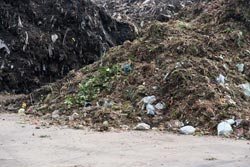Turning wet biomass waste into high-value products

Wet Biomass residues in the north of Germany. <br>© ttz Bremerhaven<br>
A new research project supported by the European Union with the intention to find new applications for wet biomass waste materials has successfully been started.
Eight project-partners from four different EU-countries are going to work together on the “NEWAPP”-project for the next 30 months. The project focusses on the application of the HTC process with which wet biomass waste can be transformed into coal-like products.
Among the participants are research facilities and industry experts from associations and companies: The Brussels-based EUBIA (European Biomass Industry Association) coordinates the consortium of the Spanish National Research Council (CSIC, Spain), the Association of cities and regions for recycling and sustainable resource management (ACR+, Belgium), the Federal Association of Secondary Raw Materials and Waste Management (bvse, Germany), the Technical University of Denmark, Ingelia S.L (Spain), Terra Preta (TP, Germany) and ttz Bremerhaven (Germany).
According to the project group, about 120 to 140 million tons of biomass waste, i.e. wet agricultural residues, wet municipal waste such as foliage, grass or food waste, are produced every year in the EU. 67 % of the materials are incinerated or landfilled; only minor amounts are composted, digested anaerobically or used as animal fodder.
“The wet biomass waste streams are abundantly available but intelligent processes to handle them hardly exist. These materials are a valuable resource which can be transformed into products with benefits for waste management, different industries and renewable energies. It is our aim to divert them from landfill and use them in a resource-efficient way”, Andrea Salimbeni (EUBIA) explains.
NEWAPP considers HTC (hydrothermal carbonisation) a cost- and resource-efficient as well as environmentally sound way to reduce waste and substitute primary fuels at the same time. In an HTC process, biomass is exposed to moderate temperatures and pressures in the presence of water and thereby converted into two main products: a coal-like product (HTC carbon) and a water phase rich in plant nutrients.
During the next 2.5 years, NEWAPP will start by treating five wet biomass waste streams in Ingelia’s HTC plant and then focus on developing a new technical utilization pathway for turning bio waste into high value products. The group will be explore what different products can be obtained from the selected waste streams after the HTC process, develop quality and safety standards and techniques for HTC products. Possible applications of the HTC products are fuel, activated carbons for water treatment, soil remediation or carbon sequestration schemes. Business plans for promising scenarios will be prepared.
The project is part of the 7th Framework Programme of the European Union. The budget consists of approximately 2.58 Mio Euro with a EU-contribution of approximately 1.76 Mio. Euro. (Source: bvse / EU-Research Project “NEWAPP”)
For further questions:
EUBIA- European Biomass Industry Association, Andrea Salimbeni, andrea.salimbeni@eubia.org
ttz Bremerhaven, Bárbara De Mena Pardo, bdemena@ttz-bremerhaven.de
Media Contact for ttz Bremerhaven:
Christian Colmer
Head Communications
ttz Bremerhaven
Fischkai 1
D-27572 Bremerhaven (Germany)
Tel.: +49 (0)471 80934 903
Fax: +49 (0)471 4832 129
ccolmer@ttz-bremerhaven.de
Weitere Informationen:
http://www.ttz-bremerhaven.de
http://www.facebook.com/ttzBremerhaven
http://www.twitter.com/ttzBremerhaven
http://www.xing.com/companies/ttzbremerhaven
Media Contact
More Information:
http://www.ttz-bremerhaven.deAll latest news from the category: Ecology, The Environment and Conservation
This complex theme deals primarily with interactions between organisms and the environmental factors that impact them, but to a greater extent between individual inanimate environmental factors.
innovations-report offers informative reports and articles on topics such as climate protection, landscape conservation, ecological systems, wildlife and nature parks and ecosystem efficiency and balance.
Newest articles

Superradiant atoms could push the boundaries of how precisely time can be measured
Superradiant atoms can help us measure time more precisely than ever. In a new study, researchers from the University of Copenhagen present a new method for measuring the time interval,…

Ion thermoelectric conversion devices for near room temperature
The electrode sheet of the thermoelectric device consists of ionic hydrogel, which is sandwiched between the electrodes to form, and the Prussian blue on the electrode undergoes a redox reaction…

Zap Energy achieves 37-million-degree temperatures in a compact device
New publication reports record electron temperatures for a small-scale, sheared-flow-stabilized Z-pinch fusion device. In the nine decades since humans first produced fusion reactions, only a few fusion technologies have demonstrated…





















